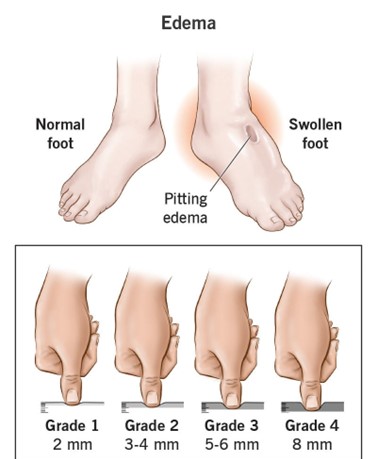A nurse is caring for a client who has heart failure and has gained 2 kg (4.4 lB. over the last 24 hours. Which of the following interventions should the nurse take?
Reduce the client's sodium intake.
Restrict the client's protein intake.
Weigh the client once per week.
Provide the client with three large meals per day.
The Correct Answer is A
Choice A reason: Reducing the client's sodium intake is an appropriate intervention for the nurse to take because it can help prevent fluid retention and edema, which are complications of heart failure. Sodium intake should be limited to 2 g per day or less for clients who have heart failure.
Choice B reason: Restricting the client's protein intake is not an appropriate intervention for the nurse to take because it can cause malnutrition and muscle wasting, which can worsen heart failure. Protein intake should be adequate to meet the client's nutritional needs and support cardiac function. Protein intake should be about 0.8 to 1.2 g per kg of body weight per day for clients who have heart failure.
Choice C reason: Weighing the client once per week is not an appropriate intervention for the nurse to take because it can delay the detection and treatment of fluid overload, which can worsen heart failure. The client should be weighed daily at the same time and with the same scale and clothing to monitor fluid status and adjust medication dosage.
Choice D reason: Providing the client with three large meals per day is not an appropriate intervention for the nurse to take because it can increase the workload of the heart and cause dyspnea, fatigue, or chest pain, which are symptoms of heart failure. The client should be provided with small, frequent meals that are low in sodium, fat, and cholesterol to reduce cardiac stress and promote digestion.

Nursing Test Bank
Naxlex Comprehensive Predictor Exams
Related Questions
Correct Answer is B
Explanation
Choice A reason: Hot dog cut in fourths is not an appropriate food choice for toddlers because it is still a choking hazard. Hot dogs are cylindrical and firm, which can block the airway of a child. Hot dogs should be avoided or cut into thin slices and small pieces before offering to toddlers.
Choice B reason: Cooked spaghetti with sauce is an appropriate food choice for toddlers because it is soft, easy to chew, and provides carbohydrates, protein, and vitamins. Cooked spaghetti can be cut into short strands and mixed with sauce to make it more appealing and moist for toddlers.
Choice C reason: Steak cut into small pieces is not an appropriate food choice for toddlers because it is tough, dry, and hard to chew. Steak can cause choking or difficulty swallowing for toddlers who have not developed their molars and chewing skills. Steak should be avoided or minced and moistened before offering to toddlers.
Choice D reason: Caramel popcorn is not an appropriate food choice for toddlers because it is sticky, sweet, and hard. Caramel popcorn can stick to the teeth and gums, causing dental caries and gum infections. Popcorn can also cause choking or aspiration for toddlers who have not mastered their swallowing reflex. Popcorn should be avoided until the child is at least 4 years old.
Correct Answer is C
Explanation
Choice A reason: Potassium 3.5 mEq/L is not a finding that indicates fluid volume deficit because it is within the normal range, which is 3.5 to 5.0 mEq/L. Potassium is an electrolyte that regulates nerve and muscle function, acid-base balance, and fluid balance. Potassium level can be affected by various factors, such as diet, medication, kidney function, and dehydration.
Choice B reason: Sodium 145 mEq/L is not a finding that indicates fluid volume deficit because it is within the normal range, which is 136 to 145 mEq/L. Sodium is an electrolyte that regulates blood pressure, blood volume, and fluid balance. Sodium level can be affected by various factors, such as diet, medication, kidney function, and fluid loss.
Choice C reason: Hematocrit 53% is a finding that indicates fluid volume deficit because it is above the normal range, which is 38 to 50% for men and 34 to 46% for women. Hematocrit is the percentage of red blood cells in the total blood volume. Hematocrit level can increase due to dehydration, which causes hemoconcentration or increased blood viscosity.
Choice D reason: HbA1c 5% is not a finding that indicates fluid volume deficit because it is within the normal range, which is less than 5.7%. HbA1c is the percentage of hemoglobin that is attached to glucose. HbA1c level reflects the average blood glucose level over the past two to three months. HbA1c level can be affected by various factors, such as diabetes, anemia, and medication.
Whether you are a student looking to ace your exams or a practicing nurse seeking to enhance your expertise , our nursing education contents will empower you with the confidence and competence to make a difference in the lives of patients and become a respected leader in the healthcare field.
Visit Naxlex, invest in your future and unlock endless possibilities with our unparalleled nursing education contents today
Report Wrong Answer on the Current Question
Do you disagree with the answer? If yes, what is your expected answer? Explain.
Kindly be descriptive with the issue you are facing.
